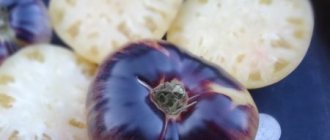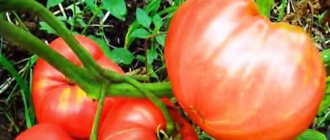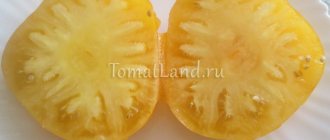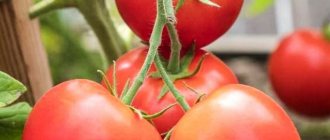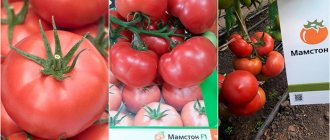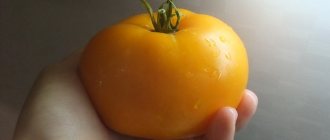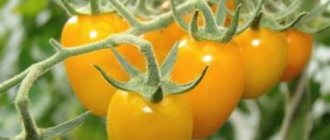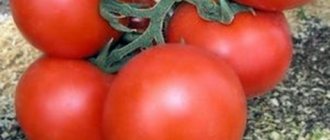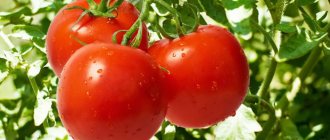Spring is a time of pleasant troubles for amateur agronomists, when it is necessary not only to prepare their garden plot for the active growth and development of perennial plants and shrubs, but also to think about the quality and yield of annual crops. Tomatoes are an integral part of any garden. They are doubly valuable if they are easy to care for, have high fertility and tasty fruits. Rio Grande tomatoes belong to this type.
Description and characteristics of the variety
The cultivar was bred in Holland. Original Rio Grande tomatoes are sold by the natural farming center “Siyanie”, agro, “Usadba” and a number of other seed centers, so there are no problems with purchasing planting material.
The variety is popular, despite the fact that it is not included in the State Register. Plants are suitable for growing in open ground and greenhouses. Cultivation on balconies, in containers and hanging flowerpots is possible.
The variety is mid-season; 115 days should pass from germination to harvesting. The fruits are medium in size, weighing just over 100 g. Oval in shape, red-pink in color. The cross-section shows that the tomatoes are very fleshy and there are few seeds in the seed chambers.
The taste is excellent - sweetish with a slight sourness. The fruits contain a lot of dry matter, so they are suitable for whole pickling and summer salads, but it is not recommended to use them for juices.
The bush is determinate, small, with few leaves. The height of an adult plant is 50-60 cm.
Up to 10 clusters are formed on the plant, which will ripen throughout the summer, providing fruits for 3 months.
Agricultural technology
In addition to growing in greenhouses and open ground, Rio Grande tomatoes successfully decorate balconies. Having compact bushes, they are suitable for design, landscaping, and grow safely in flowerpots (pots). Sowing is done in containers for the purpose of preliminary preparation of seedlings. 2 months (60 days) are counted before planting on the beds. The process includes the following steps:
- sow in boxes with nutritious soil;
- create greenhouse conditions by covering the container with film;
- water moderately;
- ventilate crops;
- provide sufficient lighting and create temperature conditions;
- make a pick (plant them in separate pots), there is no need to form a bush.
2 or 3 weeks before transferring to the beds, the seedlings are hardened off by placing the boxes on the balcony. For successful fruiting and plant health, you must adhere to the following rules:
- The Grand tomato does not need to be planted in the same place every year;
- It is better to place it where cabbage, legumes, and greens grew. But do not plant after peppers or eggplants;
- Requires deeply loosened, very fertile soil;
- Watering should be moderate, and timely application of fertilizers is also necessary.
The feeding process is carried out in the following stages:
- the first nutrient solution is diluted mullein, in a ratio of 1 to 5, or bird droppings 1:15;
- after 2 weeks - 25 grams of ammonium nitrate are stirred in a bucket of water, add 60 g of superphosphate, 15 g of potassium salt, 1 g of boric acid dissolved in 0.5 liters of boiling water;
- top dressing No. 3 – 30 g of saltpeter, 40 g of superphosphate, 70 g of potassium salt;
- 4 and 5 times - add 200 g of wood ash to 10 liters of water.
Feeding process
Apply 1 liter of fertilizer to each bush. By growing tomatoes correctly, you can get a healthy plant, protected from pests and diseases. Additional prevention against fungi consists of spraying with phytosporin and other non-toxic biological preparations. By mulching the soil with humus and straw, we get rid of the danger of late blight. We also ventilate the greenhouse and water it until the top layer of soil dries.
Insecticides destroy pests and are used before the plants bloom profusely and the ovaries begin to appear. Ammonia dissolved in water will help against slugs when sprayed systematically. For aphids, wash the stems and leaves with soapy water.
Note! In warm climates, the variety is planted directly into the ground in May, making holes for the seeds. After watering, cover the area with film.
Features of cultivation and storage
Tomatoes picked at technical ripeness are stored at +10 degrees for two to three months, slowly ripening. This allows you to significantly extend the period of consumption of fresh vegetables, so it is highly recommended to plant Rio in regions with short summers.
Since the variety is not early, it is sown in open ground or a greenhouse with seedlings whose age should be at least 40 and no more than 60 days. Cultivation without seedlings is possible only in the south. There should be no more than 5 adult bushes per square meter.
Preventing troubles in the garden
The “Rio Grande” variety is practically not afraid of such traditional nightshade diseases as white and gray rot and late blight. However, to prevent possible infection, it is worth treating the soil with a solution of potassium permanganate or copper sulfate before planting. To prevent fungal diseases, the beds should be mulched with humus and straw. You can spray the bushes with phytosporin.
Fruits of the Rio Grande variety
Among insects, the enemies of this variety include aphids and naked slugs. The first pest is removed using a soap solution. But the second pest is removed by spraying with a solution of ammonia.
The “Rio Grande” variety is recommended to be planted by people who are taking their first steps in gardening. In its cultivation, you can make some mistakes and still get a good harvest.
Tomato Rio Grande
Description and characteristics of the Rio Grande tomato variety, reviews, photos
Mid-season (110-120 days from germination to ripening), determinate, medium-sized, productive tomato variety.
Recommended for growing in open ground and film shelters. In the southern regions, this variety is suitable for seedless cultivation. Bush 0.7-1 meter high, regular leaf type. It requires tying the plant to a support and moderate pinching.
Basic qualities of fruits
The fruits are smooth cream, dense, red in color at ripeness, weighing 100-140 grams, sweet and tasty. Not prone to cracking, with thick skin, durable and transportable. These tomatoes are universal in purpose - good for both fresh consumption and whole-fruit canning.
Advantages of the variety : resistance to diseases and unfavorable growing conditions, heat resistance, abundant fruiting, smooth ripening of fruits, excellent transportability.
Features of cultivation, planting and care
Sowing the seeds of this variety of tomatoes for seedlings is carried out 60-65 days before the intended planting in the ground. Picking - at the stage of 2 true leaves. When transplanting seedlings to a permanent place, it is recommended to place 4-5 plants per 1 sq.m. Planting pattern: 50 x 40 cm.
Further care for tomatoes consists of timely watering, weed removal, pinching, fertilizing and preventive measures to protect the crop from diseases and pests.
In some catalogs the variety can be found under the name Rio Grand .
This variety is not listed in the State Register of Breeding Achievements of the Russian Federation.
Rio Grande tomatoes on video
If you grew Rio Grande tomatoes, please write what the yield and taste of the fruit was like in your climatic conditions. Will you grow them again? How do you rate the disease resistance of this variety? Briefly describe what, in your opinion, are the advantages and disadvantages of this tomato. If possible, attach a photo of the entire bush or individual fruits you grew to your comment. Thank you!
Your reviews of the Rio Grande tomato and additions to the description will help many gardeners evaluate this variety more objectively and decide whether it is worth planting or not.
Rio Grande tomato variety: a Dutch favorite variety that has not lost ground for several decades
For a Russian gardener, a tomato in a personal plot is an almost obligatory crop to grow. But the choice of varieties bred by domestic and foreign breeders is so wide that it is easy to get confused in this variety, especially for an inexperienced gardener. New varieties are constantly appearing on the market, and not everyone manages to gain popularity for a long time. The Rio Grande tomato receives consistently good reviews. Gardeners value it for its low maintenance requirements, high productivity, ability to adapt to different weather and climatic conditions, and the versatility of the fruit's purpose.
Varietal characteristics of the Rio Grande tomato
The Rio Grande tomato (sometimes found in catalogs under the names “Rio Grande Original” or “Rio Grand”) is a variety bred by Dutch breeders quite a long time ago. Over the course of several decades, it has become a “classic”, gaining popularity among both professional farmers and amateur gardeners all over the world.
The Rio Grande tomato, bred in the Netherlands, is popular among gardeners and farmers around the world
Russian gardeners also appreciated the variety. Rio Grande is suitable for cultivation both in open and closed ground, and accordingly, can be grown in most of the territory of Russia. One of its main advantages is the ability to adapt to a wide range of climatic and weather conditions, consistently producing crops, even if the summer is not very successful in this regard.
Even novice gardeners who are not very lucky with the weather in the summer can grow a crop of Rio Grande tomatoes.
The bushes are very compact, of a determinate type, with relatively few leaves. The height is artificially limited by breeders; upon reaching the declared “limit” of 60–70 cm, growth stops and a fruit cluster is formed at the top. This “small size”, coupled with high productivity, makes it possible to grow Rio Grande even on balconies and verandas. In a greenhouse, a bush can stretch up to 1 m, but this is already the limit.
The Rio Grande tomato bush cannot exceed the dimensions specified by the breeders
According to the ripening period, the variety is classified as mid-early or mid-ripening. It depends on the climate in the growing region. 105–120 days pass from the moment the seeds are planted. In the southern regions, in subtropical conditions, fruits begin to be harvested in the last ten days of June, in regions with a temperate climate - in the first half of July. The fruiting period extends until at least September, and can last until frost.
The harvest on Rio Grande tomato bushes ripens gradually, the fruiting period is extended
The yield, despite the modest size of the plants, is quite high. On each bush, 8–10 fruit clusters are formed, containing 8–12 tomatoes. The fruits are smooth, oval or plum-shaped, weighing 100–115 g (some specimens weigh 130–150 g, but rarely). During the summer, 7–10 kg are removed from one bush. The minimum indicator, if you practically forget about caring for plants, is 4–4.5 kg. Marketable fruits 98%.
Rio Grande tomato fruits look very presentable
Video: how to increase the tomato yield using competent agricultural technology
The skin is glossy, pink-red. The taste is “classic”, tomato, with a slight sourness, there is a pronounced aroma. Some consider the lack of a characteristic, recognizable taste to be the disadvantage of Rio Grande, but most gardeners do not consider themselves gourmets, so they are happy with everything.
There is almost no juice or seeds in Rio Grande tomatoes; they consist mainly of pulp
The fruits are very fleshy, with a high content of dry matter. There is practically no juice in them. If you try to squeeze it out, you will get something more like tomato paste. This is perhaps the only thing for which Rio Grande tomatoes are unsuitable. Basically, their purpose is universal. The fruits are consumed fresh, added to main courses, sauces, canned, prepared tomato paste, dried, dried, even frozen.
Gardeners growing Rio Grande tomatoes especially praise the taste and presentation of salted and pickled fruits
Tomatoes retain their presentable appearance and brightness of color during heat treatment due to the presence of a dense, but not hard skin. It also determines that tomatoes are practically not susceptible to cracking, their excellent keeping quality, transportability and even suitability for mechanized harvesting (for this, the variety is especially valued by professional farmers).
The skin of Rio Grande tomatoes is dense, but not hard.
Fruits can be harvested both upon reaching full ripeness and at the stage of technical maturity. The latter option further extends the already long shelf life of tomatoes (2.5–3 months). In optimal conditions, green tomatoes will last until the New Year without any problems.
Rio Grande tomatoes, collected in a state of technical ripeness, ripen quickly at room temperature and are stored in a dry and cool place for about three months without compromising taste and quality

